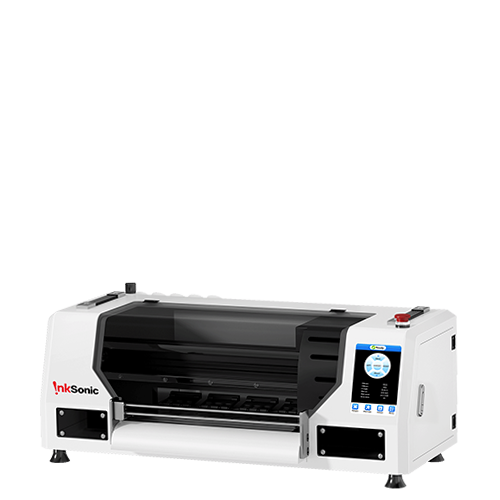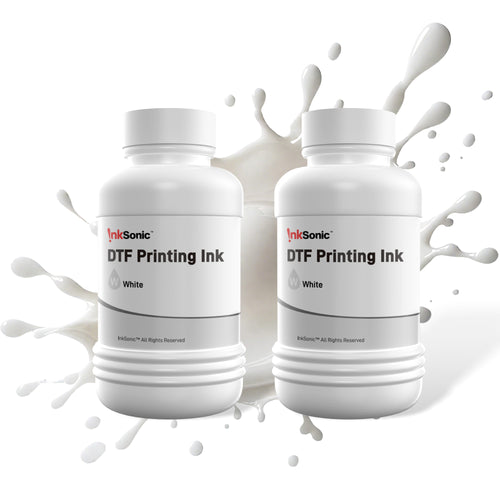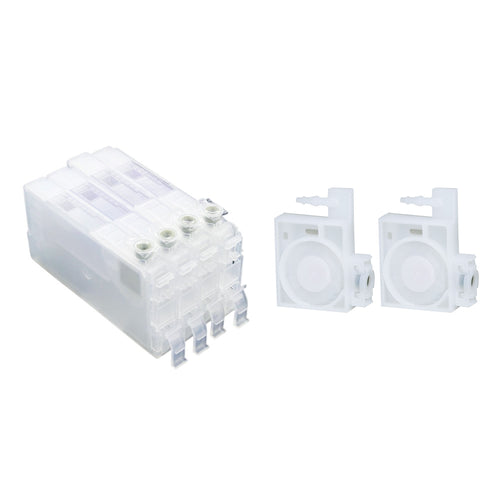DTF Supplies

Upgrade your workflow with our complete range of DTF supplies designed for both beginners and professionals.
From essential DTF printing supplies like films, powders, and inks to specialized DTF printer supplies that keep your equipment running at peak performance, we’ve got everything you need in one place. Whether you’re producing custom apparel or scaling your business, we provide the best DTF supplies to ensure durability, vibrancy, and efficiency. Our curated selection of the best DTF printer supplies helps you achieve flawless transfers with ease, making every print job smooth, reliable, and profitable.
Main Types of DTF Supplies
When it comes to DTF supplies, not all products are created equal.
DTF Inks
Quality of ink is crucial in DTF printing as the inks play the key role of image transfer and print quality.
When choosing DTF inks, the manufacturer declares that there are three aspects that need to be prioritized:
Color Vibrancy, in order for the ink to produce rich and vivid colors;
Durability, which means the prints can survive repeated washing without color bleed.
Compatibility, so the ink is compatible with their DTF printer model, to get the maximum output.
DTF Films
The DTF film is a foundation that is essential for your design. PET films are the most prevalent in the market because they are strong and clear. Films exist in different kinds, primarily distinguished by peel type—hot peel, which allows you to peel the film immediately after pressing, and cold peel, which requires the transfer to cool before peeling.
After choosing a DTF film, most customers have the following key factors in mind:
Print quality, where the film is of high clarity and resolution.
Ease of use, where they choose the release type that suits their heat press technique and desired finish;
Cost-effectiveness, where the quality vs. cost ratio is adequate, especially when high-volume printing is in question.
TPU Powders
TPU powders are essential to the DTF printing process as they attach the printed image to the garment, so consistent coverage is key to equal adhesion and durability throughout its lifespan.
The curing characteristics of the powder must be compatible with the heat press temperatures so that it melts and sticks according to temperature and pressure.
Proper storage in a low-humidity environment is also required to prevent clumping and maintain functionality.
In selecting TPU powders, most customers initially seek particle size and printing consistency, strong bond strength for repeated washing and wear, and ease of application (hand-applied or on a vibrating machine).
RIP Software for DTF Printing
Raster Image Processor (RIP) software is a necessity for use with DTF printing because it takes your digital design and translates it into a usable format for your printer, in addition to color profiles, white under base application control, and even print head adjustment.
Best-Selling for DTF Supplies
Are you worried that your DTF supplies are running out too fast, leaving you with incoming orders but not enough supplies to fulfill them? You're not alone—this is one of the most common concerns among DTF printer users, especially small business owners and home-based entrepreneurs.
DTF printing needs a consistent supply, either ink or film or TPU powder. When any of the various supplies run out unexpected in your DTF printing process, it puts the production in danger, in risk of a missed deadline, and brings the chance to find an alternative source for the customer's needs. The importance of forward planning and keeping on hand the most used items is clear.
That's why you don't need to worry, we have made it easy for you to stay prepared by showing you the most common DTF printer supplies our customers always buy together.
Necessary Supplies in DTF Printing Process
When it comes to running a successful DTF printing operation, DTF ink, PET film, and TPU powder are the three core supplies that drive your daily production.
DTF ink provides the color and detail of your design while white ink typically gets laid down first and consumed much faster than color ink. Since it is laid down on nearly every print you make, it often tends to go quicker, with some production runs having it account for up to 60-70% of total ink usage. White ink is one of the most frequently replenished inventory items in a DTF business; therefore, allowing for fast and frequent restocking.
PET film is used as the medium of transfer for the designs, and one needs to maintain a consistent supply of this available, particularly when it comes to large or time-sensitive orders. To run out of film in the middle of the job can stop your production in its tracks. TPU powder, too, is important to combine the ink with the clothing during the heat press process, and without it, no transfer can be achieved.
To avoid unwarranted downtime or missed deadlines, you may want to consider having a little extra stock on hand. By having these essentials tracking stock, you are always prepared for rush orders, seasonal spikes in orders, or simply large volume jobs to make your DTF business more reliable, effective, and most importantly, profitable.
Essential Materials for UV DTF Printing
UV DTF printing is an adaptable process that will transfer bright designs to many materials with specialized film, UV DTF ink, and topical protective varnish.
The A/B film provides the base for the printed design, while the UV DTF ink produces bright, durable colors that bond directly to the substrate.
The protective varnish is a layer of material that produces the benefits of additional protection, enhanced adhesion, durability, and is resistant wear, resulting in high-quality prints that are built to last.
Why Choose Our DTF Powder, Film, and Ink?
DTF Powder
Our hot melt adhesive powder is compatible with all DTF printers and PET films, suitable for all materials such as cotton, polyester, blends, etc., with a particle size of ~80μm to ~200μm and strong adhesion.
DTF Transfer film
Our DTF transfer film is ready to work its magic on cotton or dark, leather, nylon, denim, polyester, or synthetic fibers, or any crazy mix of fabrics you can think of. Want a bit of sparkle? Choose our glow-in-the-dark or gold film options to add that little something extra.
DTF Ink
Our DTF Ink is like the VIP of the DTF Ink world. Crafted with a top-secret Japanese formula featuring German solvents, premium Japanese resins, and vibrant color pastes, it costs three times more than your average ink—but hey, you get what you pay for! We refine it through a three-level process to keep ink consumption low and quality during high-speed runs. Plus, we’ve added amino acids to keep it nice and moisturized, so your printhead never throws a tantrum from ink dryness.
Key Features & Benefits of InkSonic DTF Supplies
Upgrade your print shop with premium DTF supplies engineered for reliability, consistency, and vivid results. Each component—from ink to film to adhesive powder—is carefully selected to deliver smooth printing performance and professional-grade outcomes.
-
Vibrant, Long-Lasting Color: InkSonic DTF inks offer high pigment density and smooth flow for bold, wash-resistant prints on both light and dark garments.
-
High-Quality PET Film: Available in hot-peel and cold-peel options, our films ensure sharp image transfer, easy peeling, and consistent results every time.
-
Premium TPU Adhesive Powder: Melts uniformly without clumping or yellowing, providing excellent bonding qualities and a soft hand feel on fabric.
-
Precision DTF Formulation: Each product goes through thorough testing with Epson based DTF systems like the L1800 and XP600, lessening clogging and down time.
-
Reliable Supply Chain: Batches provide consistent quality, allowing you to confidently meet customer order without print variations or color drift.
With InkSonic DTF supplies, every print showcases your shop's emphasis on quality—vibrant, strong, and made to last.
Best Practices for Using DTF Supplies
Expecting flawless transfers is more than just having great equipment, but it’s more about using your supplies correctly. Utilize the tips given to achieve consistent results and prolong the life of your materials:
-
Store Smart: Keep inks in an upright position and keep them in a cool (15-25 °C / 59-77 °F), dark space to hinder settling of the pigment; reseal film rolls and powder bags tightly after every use.
-
Carefully Handle Film: Always avoid finger prints or dust on the film surface; store PET film flat so it won’t curl.
-
Spread Powder even: After pick printing off the excess adhesive powder, do it in an even layer too—If you have a clump you can burn the film or not cure evenly.
-
Watch the humidity: Humidity affects powder to adhere and ink drying well; keep the environment stable around 45-60% RH for optimal printing quality.
-
Mix ink: With white ink stirred regularly before use. This will keep it from having inconsistent ink and prevent nozzles from being clogged.
Consistent care of your DTF consumables means consistent quality in your prints—less waste, smoother colors, and longer-lasting designs.
Best DTF Printer Supplies Help You Complete DTF Printing Smoothly
The right choice of DTF supplies is the key to the seamless flow of your print business and good designs. From great inks and durable DTF PET films to good TPU powders and the newest RIP software, every element plays a role in the success of your process. Having a stock of quality DTF materials, you have steady production, less downtime, and deliver outstanding results that bring repeat customers back. Invest in top-notch materials today and watch your DTF printing process realize its optimum shape.














































![Luminous A3 DTF Film Rolls 12"x 328' [Pre-order]](http://www.inksonic.com/cdn/shop/files/f13b88972b343971125d81f0d6299a6e.jpg?crop=center&height=20&v=1754618740&width=20)






